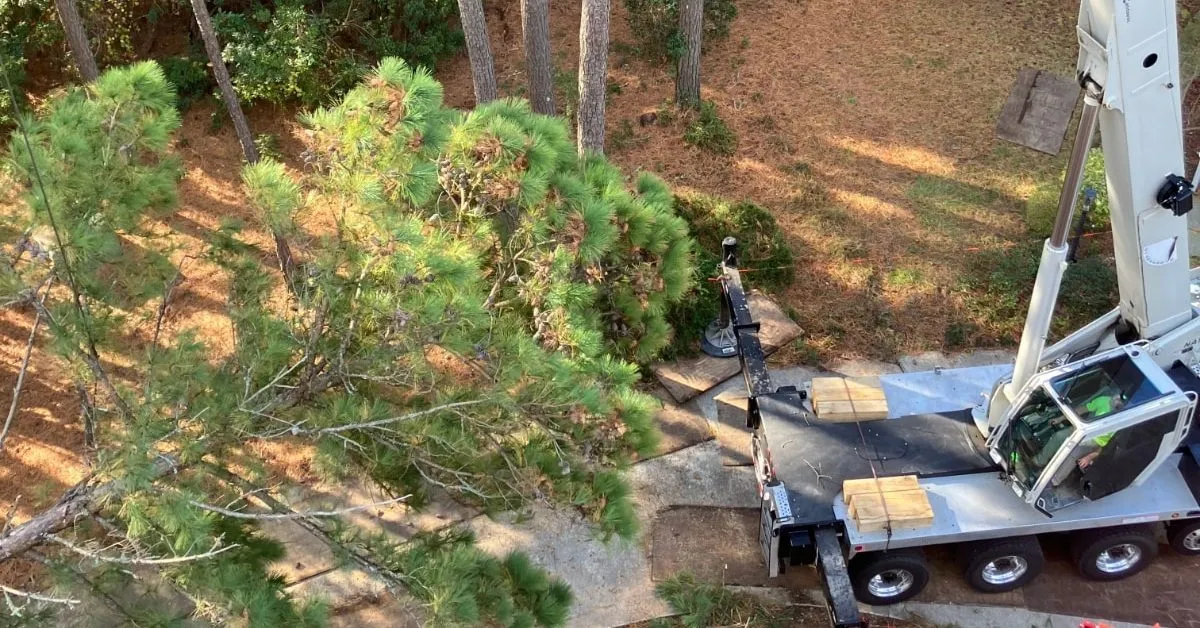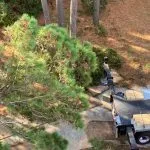
October 15, 2025
The Outer Banks of North Carolina presents one of the most distinctive environments for tree care in the Southeast. While winters here are relatively mild, coastal conditions such as salt spray, strong winds, sandy soils, and occasional ice storms create challenges that require specialized maintenance and timing.
At Albemarle Landscape and Tree Service, our team has spent years caring for trees along the barrier islands and mainland communities of the Outer Banks. We’ve learned that winter isn’t a time to ignore tree care; it’s the ideal season to strengthen, stabilize, and prepare your trees for the storms and growth cycles ahead.
This guide walks you through practical, science-based winter tree maintenance tips tailored to the Outer Banks climate.
Understanding Outer Banks Winter Conditions
Unlike inland North Carolina, the Outer Banks enjoys a maritime climate. Winter temperatures hover in the mid-30s to mid-50s°F, rarely dipping below freezing for long. Snow is rare, but the real stressors come from:
- Salt spray, which travels inland during strong northeast winds and coats leaves and bark with sodium that dehydrates plant tissue.
- Nor’easters, long-lasting coastal storms that bring sustained winds and high moisture.
- Sandy, fast-draining soils that make it harder for trees to anchor deeply or retain nutrients.
- Periodic ice storms, which can weigh down flexible limbs and expose weak branches.
These environmental factors combine to make tree care on the Outer Banks more about resilience and prevention than reaction.
Why Winter Is the Best Time for Tree Care
While many people think winter means “time off” for landscaping, it’s actually the best time of year for major tree maintenance. Here’s why:
- Dormancy equals less stress. Trees are in a low-metabolism phase, focusing energy on root health rather than leaf growth. Pruning or soil work now doesn’t interrupt active growth.
- Better visibility. With leaves gone, arborists can clearly see branch structure, decay, and crossing limbs that are hidden in summer.
- Lower pest risk. Insects and fungal spores are inactive in cold weather, so wounds from pruning are less likely to get infected.
- Safety and efficiency. Crews can maneuver more easily without dense foliage, and frozen or dry ground reduces lawn damage from equipment.
Winter work sets the stage for stronger spring growth and fewer storm-related problems later.
Step 1: Inspect Your Trees Before Storm Season
Every property should begin winter with a comprehensive inspection, especially after hurricane season. Look for:
1. Structural Weaknesses
- Leaning trunks or uneven canopies suggest root instability.
- “V-shaped” crotches or multiple main stems (called co-dominant leaders) are prone to splitting under wind pressure.
- Bark included in branch unions (where bark grows inward instead of fusing wood) is a red flag for failure risk.
2. Root Zone Health
- Check for fungal conks or mushrooms near the trunk; these are signs of internal decay.
- Watch for soil heaving, especially after rain or wind.
- Avoid piling mulch or sand against the base; it traps moisture and encourages root rot.
3. Canopy Problems
- Dead or broken branches, called hangers or “widow-makers,” must be removed immediately.
- Branches touching roofs, windows, or power lines pose serious hazards.
- Look for wind-burned or salt-damaged foliage, especially on evergreens facing the ocean.
A visual inspection now helps prevent emergency calls when the next nor’easter hits.
Step 2: Prune Strategically During Dormancy
Timing
On the Outer Banks, ideal pruning runs January through early March, late enough that deep freezes have passed but early enough for wounds to start sealing as temperatures rise.
Technique
- Cut just outside the branch collar (the slightly swollen area where branch meets trunk).
- Never leave long stubs or cut flush to the trunk; both slow healing.
- For large limbs, use the three-cut method to prevent bark tearing.
- Disinfect tools between trees with rubbing alcohol or diluted bleach.
Priorities
- Remove dead, diseased, or crossing branches.
- Thin overly dense areas to allow air and light through.
- Correct structural imbalances or remove competing leaders.
- Eliminate water sprouts and suckers that drain energy.
Well-timed pruning helps trees channel energy efficiently and reduces wind resistance, which is crucial on exposed coastal lots.
Step 3: Address Salt and Wind Exposure
Salt is one of the biggest winter stressors for Outer Banks trees. It damages both foliage and soil.
Protecting Against Salt Spray
- Erect temporary burlap or shade-cloth windbreaks on the northeast side of exposed trees.
- Apply anti-desiccant sprays to evergreens in December and reapply after heavy rains.
- Rinse salt-exposed trees with fresh water after major winter storms.
Improving Wind Resistance
- Prune dense canopies by 10–20% to reduce “sail effect.”
- Remove long horizontal limbs that act as wind levers.
- Balance growth to prevent heavy, one-sided canopies.
- Stake or cable vulnerable trees (young or newly transplanted) for temporary stability, but avoid over-tight staking that restricts movement.
Trees that can flex naturally withstand storms better than those bound too tightly.
Step 4: Strengthen the Root Zone
Healthy roots are your trees’ anchor in high winds and their main defense against salt and drought stress.
Mulching
- Apply 2–4 inches of organic mulch (pine bark, leaf compost, or shredded hardwood) from the trunk out to the drip line.
- Keep mulch 3–4 inches away from the trunk to prevent decay.
- Mulch insulates roots from rapid temperature swings and prevents winter moisture loss.
Drainage Management
- Ensure water drains away from trunks; pooling water suffocates roots in sandy soils.
- Use gentle swales or shallow trenches to guide runoff away without exposing roots.
Avoid Compaction and Contamination
- Don’t park vehicles or store firewood over root zones.
- Divert salty driveway runoff or de-icing residue away from trees with edging or barriers.
Strong roots mean trees can withstand wind, absorb nutrients, and recover quickly after storms.
Step 5: Tailor Care by Tree Type
Different species common to the Outer Banks need different winter strategies.
Live Oaks
- Extremely salt-tolerant but prone to decay if over-pruned in winter.
- Limit pruning to deadwood and hazard removal; save major shaping for late spring.
Loblolly and Longleaf Pines
- Remove dead branches and excess lower limbs to reduce wind drag.
- Watch for bark beetle holes or resin “pitch tubes,” early signs of pest activity.
Red Maples and River Birches
- Prune in late winter to establish a strong central leader and remove weak unions.
- Both species handle pruning well when dormant.
Crape Myrtles
- Never top or cut back all limbs; this ruins the structure.
- Instead, remove crossing branches and thin crowded interiors for airflow.
- Winter pruning encourages healthy bloom wood for spring.
Native Coastal Species
- Yaupon holly, wax myrtle, and eastern red cedar need minimal work.
- Focus only on clearing storm damage or managing space near structures.
A targeted approach keeps trees both healthy and true to their natural form.
Step 6: Monitor for Pests and Disease
Winter may quiet visible activity, but disease and insect signs are often easier to detect when trees are bare.
Fungal and Decay Indicators
- Shelf fungi or conks mean internal decay; call an arborist for evaluation.
- Cankers, or sunken, darkened bark patches, can spread if not pruned out.
Insect Clues
- Look for tent caterpillar egg masses on twigs; remove and destroy them before the spring hatch.
- Check bark for sawdust or small exit holes, which indicate boring beetles.
Early winter detection means easier prevention come spring.
Step 7: Care for Young and Newly Planted Trees
New plantings on the Outer Banks face special challenges such as sandy soil, wind exposure, and salt spray.
Watering and Mulching
- Water deeply once or twice a month during dry spells, even in winter.
- Apply mulch rings to retain soil moisture and prevent root temperature swings.
Staking
- Use two flexible ties that allow slight trunk movement.
- Check ties monthly to prevent girdling.
- Remove stakes after 12–18 months once roots anchor firmly.
Sunscald Protection
- Wrap thin trunks with tree wrap or white latex paint to prevent cracking on sunny, cold days.
- Remove wraps each spring to avoid pest buildup.
Formative Pruning
- Guide young trees toward a single strong leader and balanced branching.
- Avoid removing more than 25% of the canopy per year.
Early training saves money and prevents structural issues in adulthood.
Step 8: Know When to Call a Professional Arborist
While homeowners can handle light pruning and inspection, certain tasks require professional equipment and expertise:
- Tree removal or large limb pruning near power lines.
- Storm-damaged trees leaning toward structures.
- Internal decay diagnosis using resistograph or drone inspection.
- Cabling and bracing installations for structural defects.
Qualified arborists can assess complex situations safely and accurately, preventing property damage and injury.
Step 9: Maintain Records and Plan Ahead
Smart property management includes documentation and long-term planning.
- Photograph trees each winter to track health and growth.
- Keep a maintenance log of pruning dates, storm damage, and treatments.
- Plan spring planting now; research salt-tolerant, wind-resistant species such as yaupon holly, American holly, and red cedar for coastal conditions.
These records help you make data-based tree care decisions and simplify insurance claims after severe weather.
FAQs About Winter Tree Care in the Outer Banks, NC
How does salt air affect trees in the Outer Banks?
Salt air can dry out leaves, needles, and bark, leading to browning or dieback on the windward side of trees. Over time, salt also accumulates in the soil, limiting water absorption. Rinsing foliage after major storms and maintaining a thick mulch layer helps protect trees from salt stress.
What trees handle Outer Banks winters best?
Native coastal species like live oaks, yaupon holly, wax myrtle, and eastern red cedar perform best. They evolved to tolerate salt spray, sandy soils, and wind exposure common to the barrier islands. For new plantings, these species offer the best long-term resilience.
When is the best time to prune trees in the Outer Banks?
The ideal window is January through early March, when trees are dormant but before spring growth begins. Pruning during this period reduces stress, minimizes pest exposure, and allows wounds to heal naturally as temperatures rise.
How can I protect trees from nor’easter winds?
Proper pruning to thin dense canopies and remove weak or dead branches is the first line of defense. For young or newly planted trees, use flexible staking systems that allow natural trunk movement while providing temporary support. Avoid over-tight staking, which can restrict growth.
Does winter tree maintenance help prevent storm damage?
Yes. Inspections and pruning during winter identify structural weaknesses before high winds and storms arrive. Preventive care reduces the risk of falling branches, uprooting, or property damage during nor’easters and spring storms.
Should I water my trees during the winter?
Yes, especially for younger or newly planted trees. While rainfall helps, sandy Outer Banks soil drains quickly, and winter winds accelerate moisture loss. Water deeply every few weeks during dry spells to maintain root health.
Protect Your Property with Expert Winter Tree Care
Prepare your Outer Banks landscape for the season ahead with professional tree inspections, pruning, and storm preparation. Our certified arborists specialize in coastal environments and know how to keep your trees strong, stable, and healthy year-round.
Schedule your professional winter tree assessment with Albemarle Landscape and Tree Service today. Protect your trees, your property, and your peace of mind before the next storm season begins.







